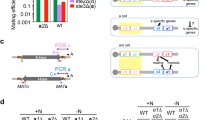Abstract
Cochhobolus heterostrophus has alternate genes (MAT-1 andMAT-2) at its mating-type locus. Transformants of aMAT-1 or aMAT-2 strain carrying a transgene of opposite mating type can self and are dual maters; the transgene, however, promotes development of pseudothecia only, not ascospores. To determine if the resident gene interferes with the function of the transgene, transformation vectors were designed to delete different amounts (2.5 kb, 5.7 kb, and 6.3 kb) of DNA at theMAT locus. Deletions occurred at a higher frequency (about 90% of transformants) with linearized plasmid than with circular plasmid (about 15% of transformants), and all three vectors were equally efficient at gene replacement. BothMAT-1 andMAT-2 could be deleted with the same set of vectors. Re-transformation of deletion strains (regardless of deletion size) with a wild-type copy ofMAT restored full mating ability, indicating that the residentMAT gene interferes with function of theMAT transgene. Moreover, sexual development was normal whether theMAT transgene integrated at the homologous or at an ectopic site.
Similar content being viewed by others
References
Chang S, Staben C (1994) Directed replacement ofmtA bymta-1 effects a mating-type switch inNeurospora crassa. Genetics 138:75–81
Coppin E, Arnaise S, Contamine V, Picard M (1993) Deletion of the mating-type sequences inPodospora anserina abolishes mating without affecting vegetative functions and sexual differentiation. Mol Gen Genet 241:409–414
Cullen D, Leong SA, Wilson LJ, Henner DJ (1987) Transformation ofAspergillus nidulans with the hygromycin-resistance gene,hph. Gene 57:21–26
Debuchy R, Arnaise S, Lecellier G (1993) Themat- allele ofPodosporn anserina contains three regulatory genes required for the development of fertilized female organs. Mol Gen Genet 241:667–673
Ferreira AVB, Glass NL (1994) TheNeurospora crassa idiomorphA contains three genes which code for proteins that resemble transcription factors. Proc 5th Int Mycol Cong., abstracts, p. 63
Gillissen B, Bergemann J, Sandmann C, Schroeer B, Bolker M, Kahmann R (1992) A two-component regulatory system for self/non-self recognition inUstilago maydis. Cell 68:647–657
Glass NL, Vollmer SJ, Staben C, Metzenberg RL, Yanofsky C (1988) DNAs of the two mating-type alleles ofNeurospora crassa are highly dissimilar. Science 241:570–573
Glass NL, Grotelueschen J, Metzenberg RL (1990)Neurospora crassa A mating-type region. Proc Natl Acad Sci USA 87:4912–4916
Herskowitz I (1989) A regulatory hierarchy for cell specialization in yeast. Nature 342:749–757
Hicks J, Strathern JN, Klar AJS (1979) Transposable mating-type genes inSaccharomyces cerevisiae. Nature 282:478–483
Kues U, Casselton LA (1993) Regulation of fungal development by mating-type genes. In: Proc 50th Symp Soc Gen Microbiol. Cambridge University Press, Cambridge, UK, pp 185–210
Leach J, Lang BR, Yoder OC (1982) Methods for selection of mutants and in vitro culture ofCochliobolus heterostrophus. J Gen Microbiol 128:1719–1729
Leubuer-Metzger G, Yoder OC, Turgeon BG (1992) Transcripts at the mating-type region ofCochliobolus heterostrophus. 6th Int Symp Mol Plant-Microbe Interact, Seattle abstract 273
Lu SW, Lyngholm L, Yang G, Bronson C, Yoder OC, Turgeon BG (1994) Tagged mutations at the ToxI locus ofCochliobolus heterostrophus using restriction enzyme-mediated integration. Proc Natl Acad Sci USA 91:12649–12653
Marsh L, Neiman AM, Herskowitz I (1991) Signal transduction during pheromone response in yeast. Annu Rev Cell Biol 7:699–728
Metzenberg RL, Glass NL (1990) Mating type and mating strategies inNeurospora. Bioessays 12:53–59
Picard M, Debuchy R, Coppin E (1991) Cloning the mating types of the heterothallic fungusPodospora anserina - developmental features of haploid transformants carrying both mating types. Genetics 128:539–547
Rothstein R (1991) Targeting, disruption, replacement, and allele rescue: integrative DNA transformation in yeast. In: Guthrie C, Fink GR (eds) Methods in enzymology: guide to yeast genetics and molecular biology. Academic Press, San Diego, California, pp 281–301
Staben C, Yanofsky C (1990)Neurospora crassa a mating type region. Proc Natl Acad Sci USA 87:4917–4921
Straubinger B, Straubinger E, Wirsel S, Turgeon G, Yoder O (1992) Versatile fungal transformation vectors carrying the selectablebar gene ofStreptomyces hygroscopicus. Fungal Genet Newslett 39:82–83
Turgeon BG, Garber RC, Yoder OC (1985) Transformation of the fungal maize pathogenCochliobolus heterostrophus using theAspergillus nidulans amdS gene. Mol Gen Genet 201: 450–453
Turgeon BG, Bohlmann H, Ciuffetti LM, Christiansen SK, Yang G, Schafer W, Yoder OC (1993) Cloning and analysis of the matingtype genes fromCochliobolus heterostrophus. Mol Gen Genet 238:270–284
Yang G, Turgeon BG, Yoder OC (1994) Toxin-deficient mutants from a toxin-sensitive transformant ofCochliobolus heterostrophus. Genetics 137:751–757
Yee AR, Kronstad JW (1993) Construction of chimeric alleles with altered specificity at theb incompatibility locus ofUstilago maydis. Proc Natl Acad Sci USA 90:664–668
Author information
Authors and Affiliations
Additional information
Communicated by H. Bertrand
Rights and permissions
About this article
Cite this article
Wirsel, S., Turgeon, B.G. & Yoder, O.C. Deletion of theCochliobolus heterostrophus mating-type (MAT) locus promotes the function ofMAT transgenes. Curr Genet 29, 241–249 (1996). https://doi.org/10.1007/BF02221554
Received:
Issue Date:
DOI: https://doi.org/10.1007/BF02221554




